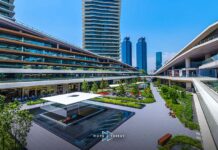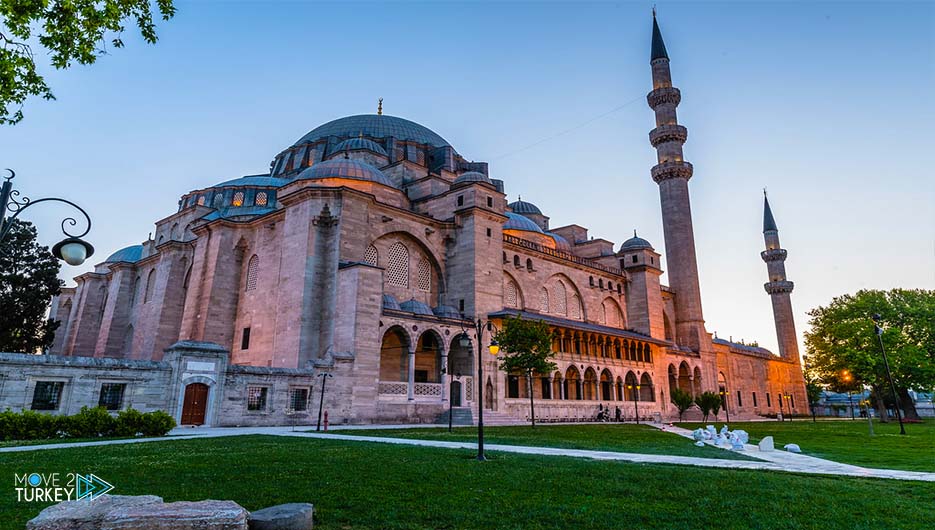
The Suleymaniye Mosque is beautiful overlooking the Bosphorus in Istanbul, there are many mosques in Istanbul, all of great historical and architectural value and of international fame.
At the top of the list is the Hagia Sophia, next is the Suleymaniye Mosque, similar to the Hagia Sophia, with the difference that less decorations were used In building interior spaces.
The Suleymaniye Mosque in Istanbul is one of the famous mosques of the Ottoman period in Turkey, which attracts countless tourists from all over the world every year.
History of the mosque
This mosque was built by order of Sultan Suleiman the First in the year 964 AH or 1556 AD, this king is also known by other names such as “the greatest”.
The construction of the Suleymaniye Mosque was entrusted to the architect Sinan, the famous Ottoman architect.
3,500 people worked for 7 years to build this mosque.
Suleymaniye Mosque in Istanbul is the place of Friday and Eid prayers.
In the past, 257 candles were used to light this mosque.
The Sulaymaniyah Mosque has 4 minarets, two with a height of 74 meters and two with a height of 56 meters.
The height of its main dome in the Suleymaniye Mosque is 53 meters.
The Mosque is built on one of the famous Istanbul hills in Eminonu district, near the Golden Horn Bay.
The result was a mosque with two minarets 74 meters long, two minarets 56 meters long, 400 windows and a dome 53 meters high.
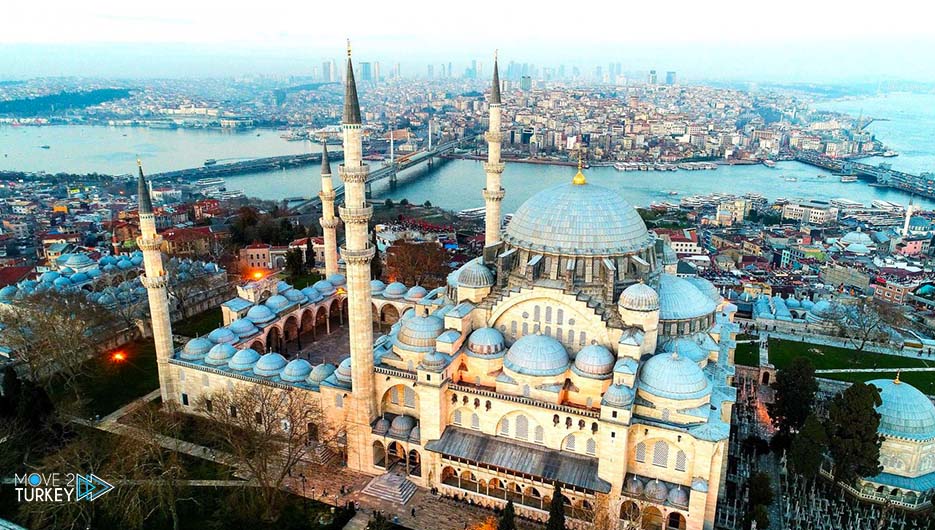
The distinctive location of Suleymaniye Mosque in Istanbul
The mosque is located on the top of a hill in the Kantarcilar region between the Ministry and the Office of the Sheikh of Islam, and it is wonderfully high to the sky.
From the Suleymaniye Mosque in Istanbul you can take a quick look at the two continents of Europe and Asia connected in this city and 2 seas surrounding Istanbul.
On the other hand, in the distance along the horizon, you can see the towering mountains that have always been a living witness to the rise of the Ottoman Empire throughout history.
The story of the minarets of the Suleymaniye Mosque in Istanbul
Perhaps the architect (Sinan), when preparing the plan for the Sulaymaniyah Mosque, considered it four minarets for no specific reason, and perhaps Sultan Suleiman was not aware of this at all.
But why were four minarets built for this mosque?
The first narration is that the mosque’s four minarets are a sign that this mosque was built by order of the king or the Sultan.
But the same is not the case with the Blue Mosque or Sultan Ahmet, even though the mosque has 6 minarets.
But the Hagia Sophia, the New Mosque, the Rustem Pasa Mosque and… they have four minarets.
Another version of the minarets of the Suleymaniye Mosque is that Sultan Suleiman wanted to present himself as the fourth Ottoman sultan.
While he was the tenth Sultan.
But many mosques in Istanbul have four minarets, if we look at the matter with this interpretation, all the builders of these mosques wanted to be the fourth Ottoman Sultan!
Smoke room of Suleymaniye Mosque in Istanbul
During the reign of Sultan Suleiman there was no electricity, so there was no choice but to use candles.
The Suleymaniye Mosque in Istanbul needed 257 candles to light.
The Architect Sinan designed a small room above the entrance door of the Suleymaniye Mosque to collect smoke from burning candles.
He also installed vents in the corners of the mosque to direct smoke into the room.
That is why this room was known as the “Smoke Room”.
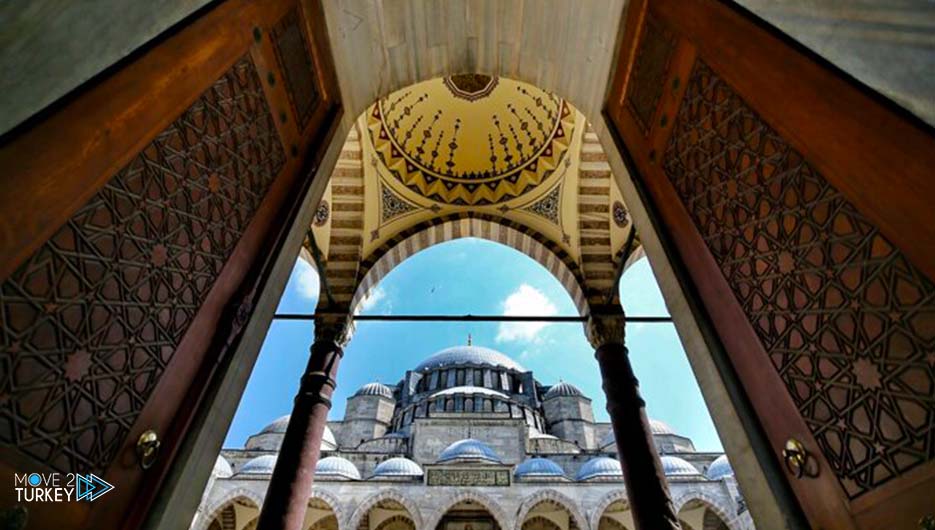
Ruins of Suleymaniye Mosque in Istanbul
Istanbul, or formerly Constantinople, witnessed fires, earthquakes, and devastation.
Over time, many buildings were damaged in these natural disasters, and many of them were completely destroyed. But one of the buildings that did not bend in the face of all this disaster was the magnificent Suleymaniye Mosque.
Exactly one century after the construction of the Suleymaniye Mosque in 1660, a great fire broke out in this mosque and destroyed it completely.
Fortunately, Sultan Mehmed IV ordered that the mosque be rebuilt completely according to his old plan.
But earthquakes did not stop, in the earthquake of 1766, part of the dome of the Suleymaniye Mosque fell.
During World War I, the mosque turned into an ammunition depot, as it exploded several times and set the mosque on fire.
In 1956 the mosque was completely restored.
Building of Suleymaniye Mosque in Istanbul
The structures of the Ottoman buildings are very large and impose themselves on the viewer. All the details used in building such a building, despite being full of glamor. All these elegance and designed decorations serve a specific purpose which is to maintain simplicity and uniqueness.
There are stained glass windows and blue Iznik tiles on the qibla wall, on both sides of the altar there are large calligraphic tiles with text from Surah Al-Fatiha, the first surah of the Qur’an.
The interior of the mosque is very impressive in terms of size, being fifty-eight by fifty-nine meters making it look like a square.
Architect Sinan made great efforts in designing this mosque to reach the size of the Hagia Sophia Mosque.
Architect Sinan did that by removing the huge dome columns and moving them to the walls of this mosque.
To do this hard work, he added a row of marble columns on both sides.
Although the Suleymaniye Mosque does not reach the grandeur of Hagia Sophia, it is much better in terms of light and spaciousness than Hagia Sophia.
In addition, given that the number of balconies in all the minarets was ten, it was related that he was considered the tenth king after Sultan Osman Gazi, who is considered his greatest predecessor.
The two minarets are located on either side of the mosque, each of them has two separate balconies. And the other two are at the other end of the mosque’s courtyard, and each has three balconies, so the total number of balconies is ten.
The three beautiful doors of the Suleymaniye Mosque pass through an oval arch and can be accessed from the front and the other sides of the courtyard.
The corridor consists of 24 arched columns, which are circular and support the same number of columns.
A pair of these arches near the door are made of igneous rocks, and the remaining twelve columns are of two pink granite and ten white marble.
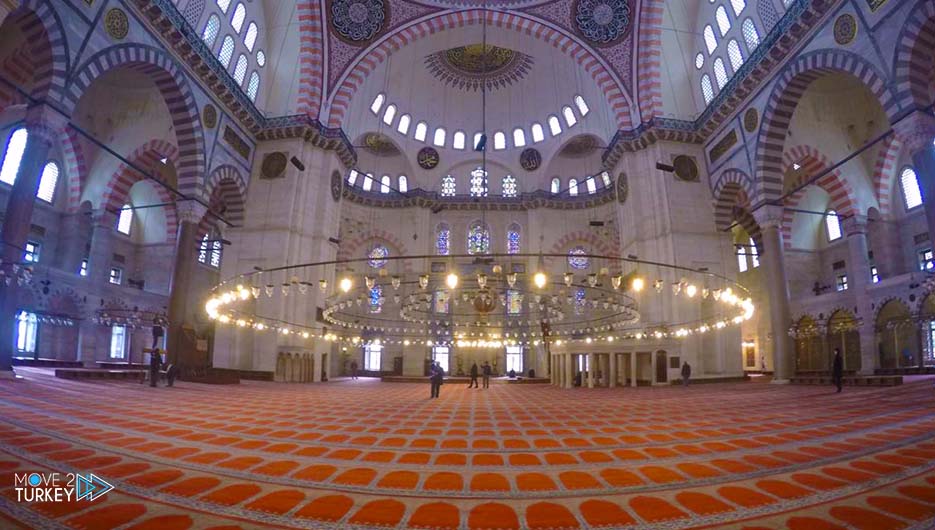
Suleymaniye Mosque facilities in Istanbul
Sultan Suleiman asked the architect Sinan to build a mosque so that it would not be only a place for worshipers.
The architect Sinan also designed a complex that, in addition to the main building of the mosque, includes a religious school, schools of Islamic jurisprudence, a hospital (Dar Al-Shifa), a medical school, an elementary school, and a hostel for tourists, and the mosque also has a bathroom, elegant kitchens and restaurants serving Ottoman cuisine.
It was also a charitable institution with other facilities, such as the kitchen in this mosque, which provided food for the poor and needy.
A welfare system was provided to feed more than 1,000 poor people in the city every day for Muslims, Christians and Jews.
And now it has been converted into a restaurant and provides tourism services to travelers.
Tombs in the Suleymaniye Mosque in Istanbul
Upon the death of Sultan Suleiman, he was buried in the southern part of the Suleymaniye Mosque, and his wife, daughter, mother and sister were also buried next to him.
Sultan Suleiman II and Sultan Ahmed II were also buried here, so that the cemetery in the southern part of the mosque became a family cemetery.
But in the northern part, outside the mosque, there is one tomb.
This is the burial place of the architect Sinan, the accuracy used in his work was so great that he is considered an architectural genius.
How can I go to the Sulaymaniyah Mosque?
The best way to get to the mosque is from Sıddık Sami Onar Alley.
Take the F1 funicular station at Taksim Square station and get off at Kabatash station.
Take the tram stop and get off at the nearest Beyazit-Grand Bazaar tram stop after taking the T1 line.
Walk about 15 minutes to reach Professor Saddik Sami Onar’s lane.
Enter the alley of Professor Seddik Sami Onar, the minarets and dome of the Suleymaniye Mosque will be visible to you, to the left of the entrance you can see a beautiful garden.
Continue this beautiful path until you reach the ablution room and then enter the grand courtyard of the mosque.
Things to know before visiting the mosque
You can enter the mosque from the inner courtyard of the mosque after taking off your shoes.
Entering the Suleymaniye Mosque in Istanbul is free and you will also be allowed to photograph with flash.
If you are interested in architecture and art, this mosque will meet your expectations more than it is, so take a camera and enjoy the grandeur of this monument.





















